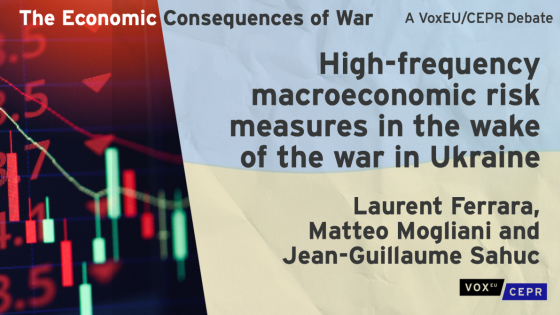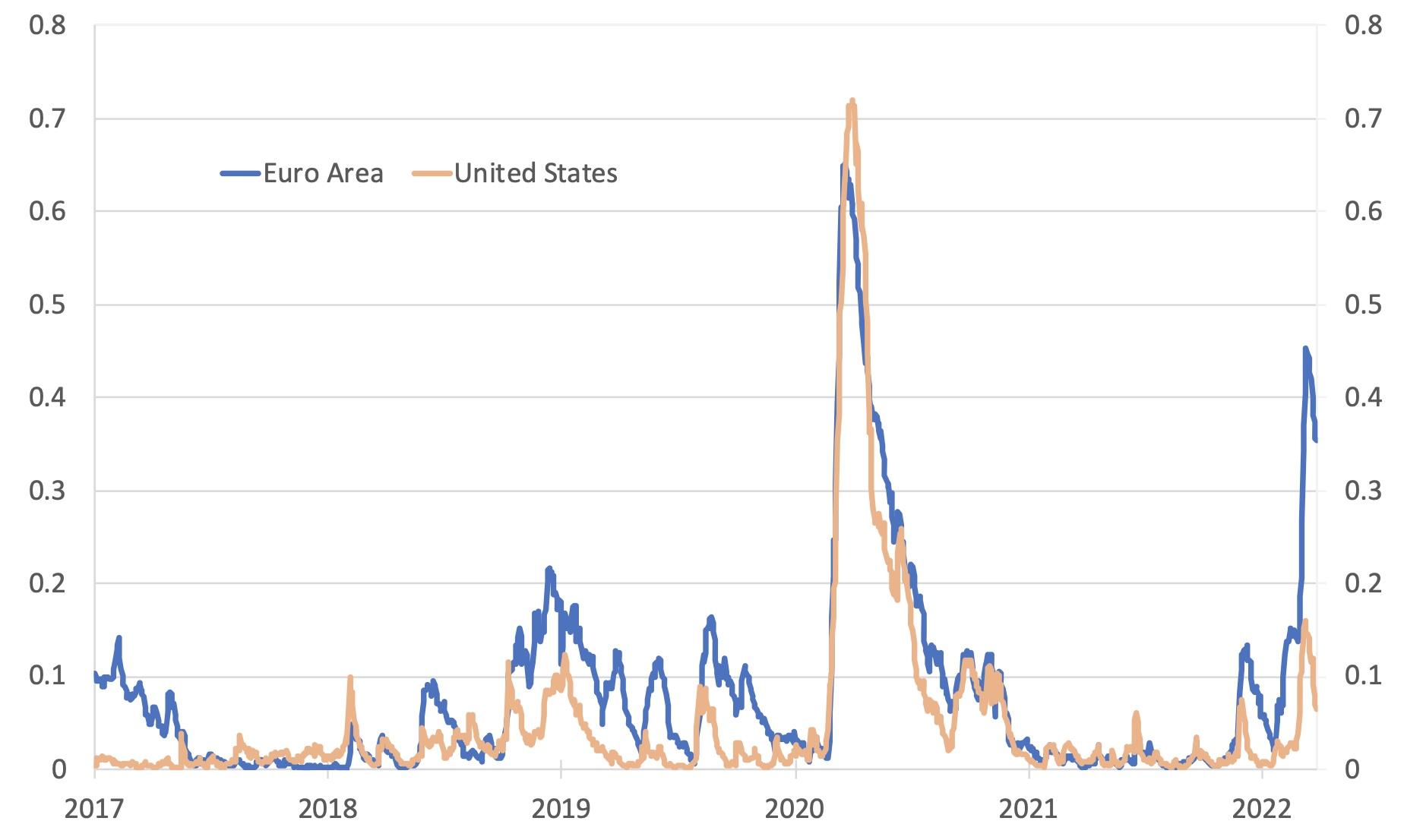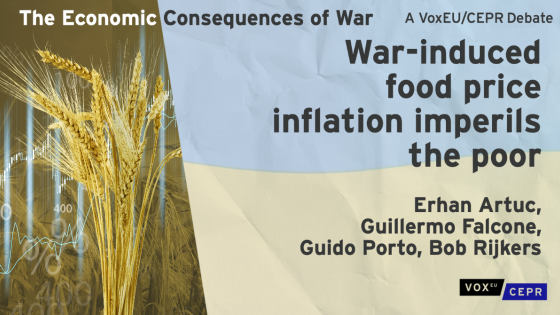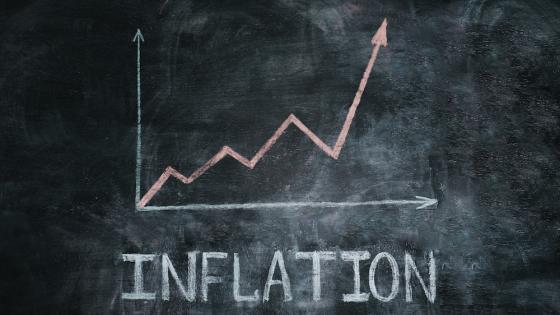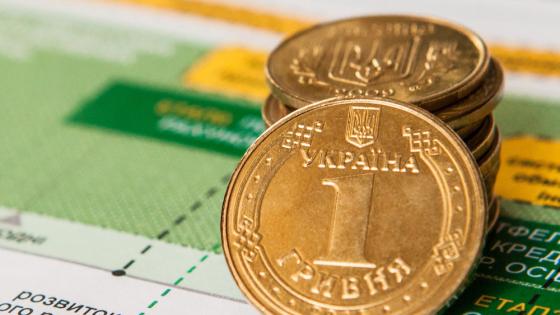Editors' note: This column is part of the Vox debate on the economic consequences of war.
The sudden Russian invasion of Ukraine generated an upward shift in various risks around the globe, ranging from rising food prices and their impact on poverty and inequalities (Artuc et al. 2022), to permanent adjustments in global supply chains (Korn and Stemmler 2022). It turns out that many financial variables also reacted sharply soon after the beginning of the war. Monitoring changes in financial stress provides valuable information on the contribution of the financial sector to current economic risks. In this respect, Adrian et al. (2019) have proposed a quarterly growth-at-risk (GaR) approach enabling the assessment of macroeconomic risks based on financial conditions indexes. Recently, we put forward in a paper an extended version of the quarterly GaR by accounting for the high-frequency nature of financial conditions indicators (Ferrara et al. 2022). Specifically, we use Bayesian mixed-data sampling (MIDAS) quantile regressions to exploit the information content of a financial stress index, leading to real-time high-frequency GaR measures for the euro area. This high-frequency approach allows us to rapidly quantify macro risks related to the war in Ukraine.
Financial stress in the euro area
The financial stress indicator that we consider is the Composite Indicator of Systemic Stress (CISS), developed by the ECB (Holló et al. 2012). The main methodological innovation of the CISS is the application of basic portfolio theory to the aggregation of five market-specific sub-indexes: the foreign exchange market, the equity market, the money market, the bond market, and the financial intermediaries. The aggregation takes into account time-varying cross-correlations between the five sub-indexes. As a result, the CISS puts relatively more weight on situations in which stress prevails in several market segments at the same time. Thus, it captures the idea that financial stress is more systemic and thus more dangerous for the economy as a whole if financial instability spreads more widely across the whole financial system.
The daily evolution of the euro area CISS until 28 March 2022 is presented in Figure 1. We observed a sharp increase in the euro area index just after the Russian invasion of Ukraine on 24 February. In mid-March 2022 the index reached a value close to 0.45, before receding slightly in the following days. However, the value of financial stress stays below that observed at the beginning of the Covid-19 crisis in 2020 and, in any case, far from that observed during the Global Crisis or the euro area sovereign debt crisis. Luckily, the ECB recently put forward a new CISS measure for the US allowing us to compare both economies on a similar basis. It is striking to see in Figure 1 that the US does not seem to have been strongly affected by financial stress – at least so far.
Figure 1 Composite Indicator of systemic stress for the euro area and the US
Note: CISS for the euro area (changing composition) and CISS data for the US are provided by the European Central Bank. Daily data until 28 March 2022.
Macroeconomic risks in the euro area
Based on this CISS, we recently proposed a new econometric approach to assess, on a high-frequency basis, a GaR measure for the current euro area quarterly GDP growth (Ferrara et al. 2022). The idea of our approach is to extend the GaR originally put forward by Adrian et al. (2019) by taking advantage of the high-frequency nature of financial conditions indexes. To this end, we developed a Bayesian mixed-frequency quantile regression model in order to gauge risks to GDP growth for the current quarter stemming from daily financial conditions. Results are presented in the form of a conditional distribution for current GDP growth (nowcasting), from which conditional quantiles can be derived. Interestingly, this exercise can be carried out on a daily basis, that is, each time we get an update of the CISS, providing us with high-frequency monitoring of macro risks.
Results from an updated version of our model are given in Figure 2. We observe that within a few days, the probability density function of conditional euro area GDP growth for 2022q1 clearly shifted to the left. The value estimated on 28 March shows a thicker left tail, highlighting an increase in downward macro risks in the wake of the start of the war in Ukraine. As regards the value of the GaR at 10%, which can be considered as the 10% quantile of this estimated conditional distribution, it went from -0.02% on 01 February to -0.90% on 28 March.
Figure 2 Probability density functions of conditional euro area GDP growth in 2022q1
Note: Authors’ computation based on Ferrara, Mogliani, Sahuc (2022)
Macroeconomic risks in the US
Based on the new US CISS measure, we also estimated a similar Bayesian mixed-frequency model for the US economy. The probability density functions of conditional US GDP growth for 2022q1, estimated at various dates, are presented in Figure 3. The shift to the left between 01 February and 28 March is less marked than for the euro area: the GaR (10%) goes from 0.30% on 1 February to 0.03% on 28 March. So overall, the GaR (10%) lost only about 0.30 percentate points in the US, compared to 0.90 percentate points in the euro area. This result suggests that macro risks in the euro area are three times higher compared to those in the US, mainly due to higher exposure to Russia in terms of commodity imports (Bachmann et al. 2022).
Figure 3 Probability density functions of conditional US GDP growth in 2022q1
Note: Authors’ computation based on Ferrara et al. (2022).
References
Adrian, T, N Boyarchenko, and D Giannone (2019), “Vulnerable growth”, American Economic Review 109(4): 1236–1289.
Artuc, E, G Falcone, G Porto and B Rijkers (2022), “War-induced food price inflation imperils the poor”, VoxEU.org, 01 April.
Bachmann, R, D Baqaee, C Bayer, M Kuhn, A Löschel, B Moll, A Peichl, K Pittel and M Schularick (2022), “What if Germany is cut off from Russian energy?”, VoxEU.org, 25 March.
Ferrara, L, M Mogliani and J G Sahuc (2022), “High-frequency monitoring of Growth-at-Risk”, International Journal of Forecasting 38: 582-595.
Holló, D, M Kremer and M Lo Duca (2012), “CISS - A composite indicator of systemic stress in the financial system”, European Central Bank Working Paper No. 1426.
Korn, T and H Stemmler (2022), “Russia’s war against Ukraine might persistently shift global supply chains”, VoxEU.org, 31 March.
